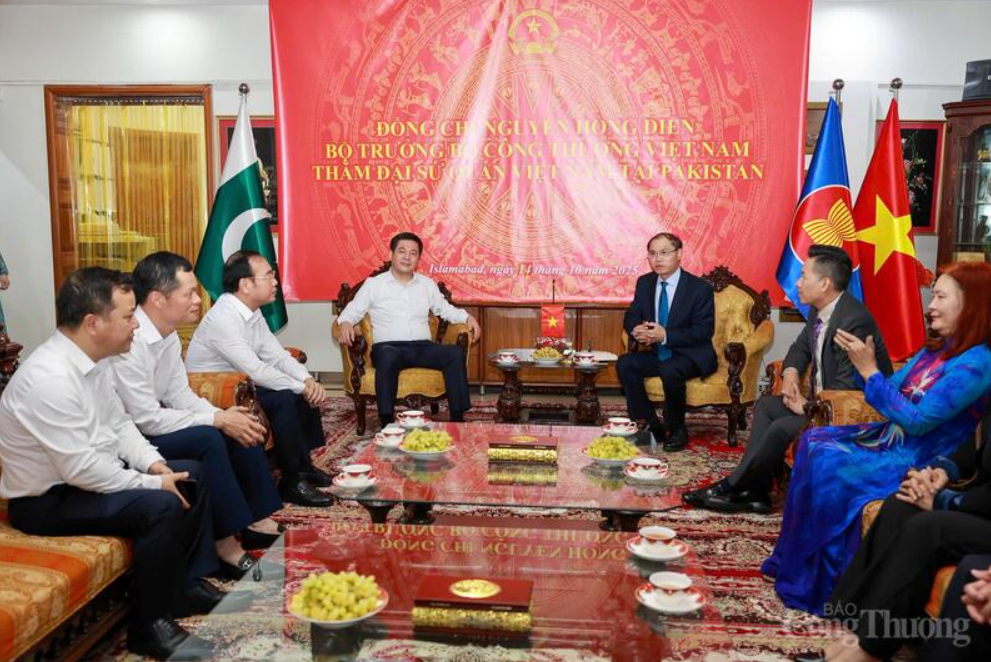
MoIT leader works with Vietnam Embassy in Pakistan
19:05 | 23/03/2025 20:44 | 15/10/2025News and Events
In the context of deepening global economic integration and the rapid emergence of the Fourth Industrial Revolution, supporting industries (SI) are regarded as the pillar of modern manufacturing. This sector ensures the supply of components, spare parts, and semi-finished products for key industries, while determining the competitiveness, innovation capacity, and the level of participation in global value chains of the economy.
As the nation’s political, economic, and cultural hub, Hanoi sees the development of supporting industries not only as a long-term strategic objective but also as an urgent task to affirm its role as a dynamic, modern, and sustainable industrial city.
However, the biggest bottleneck lies in the lack of strong linkages across the production value chain. This shortcoming prevents Hanoi’s supporting industries from realizing their full potential, while large industrial manufacturers still struggle to find stable, high-quality, and reasonably priced local suppliers.
Current situation and challenges in value chain linkage
Hanoi possesses numerous advantages for developing supporting industries. The city is home to dozens of industrial parks, over 70 industrial clusters, and thousands of enterprises operating in key sectors such as engineering, electronics, textiles and footwear. These provide a solid foundation for forming a diverse manufacturing ecosystem and gradually integrating into global supply networks.
In fact, several enterprises in the capital have become first- and second-tier suppliers for multinational corporations, particularly in the electronics and precision engineering sectors.

As Hanoi views supporting industries as the backbone of manufacturing, unlocking value chain linkages creates new momentum for the capital in the era of global integration.
However, according to the Hanoi Department of Industry and Trade, most supporting industry enterprises remain small or medium-sized, with limited capital, modest technological capacity, and weak research and development (R&D) capabilities. Many fail to meet the stringent standards on quality, delivery schedules, and cost efficiency required by major corporations.
As a result, Hanoi’s leading industrial manufacturers often rely on imported components and parts or seek suppliers from nearby provinces such as Bac Ninh, Thai Nguyen, and Hai Phong, where supporting industries have already developed more robust ecosystems.
This fragmentation causes Hanoi’s supporting industries to miss out on opportunities to expand markets and increase revenues. Meanwhile, major industrial firms face higher production costs and reduced supply chain flexibility amid intensifying competition. The lack of cohesive linkage ultimately undermines the overall competitiveness of the capital’s industrial sector, making it difficult to climb higher on the global value chain.
Compared with provinces such as Bac Ninh, where Samsung’s presence has attracted hundreds of satellite enterprises and formed a closed supporting industry ecosystem. Thai Nguyen, whose strong inflow of foreign direct investment (FDI) has fueled rapid SI growth and easy access to global corporations, Hanoi still has significant gaps in value chain connectivity. Without timely breakthroughs, the capital’s supporting industries will struggle to make a real leap forward, despite immense potential.
Unlocking bottlenecks and paving the way for breakthroughs
To unblock the flow of value chain linkages, Hanoi needs a comprehensive and synchronized strategy built upon three pillars: policy, infrastructure, and enterprise initiative.
First, municipal authorities should issue and effectively implement specific, practical incentive policies to support SI enterprises. Tax and credit incentives for technology innovation, along with R&D funding packages, will encourage enterprises to confidently participate in joint projects with major manufacturers. The city should also promote the formation of industrial linkage clusters, where SI enterprises can share resources and connect supply and demand. At the same time, training high-quality human resources, improving management capacity, and standardizing production processes according to international norms are essential.
In addition to policy mechanisms, modern and synchronized SI infrastructure is a decisive factor. Hanoi should continue to plan and invest in specialized industrial zones and clusters for supporting industries, with comprehensive transport, power, water, and waste treatment systems. Simplifying administrative procedures, reducing investment costs, and creating a favorable environment for enterprises to expand production are equally crucial.
Moreover, the city should establish technical support, technology transfer, and quality inspection centers to help small and medium-sized enterprises enhance their capacity and gradually meet international partner requirements.
Another indispensable factor is the active role of industry associations, trade promotion centers, and support organizations. These serve as bridges linking supporting industry enterprises with major industrial producers. Activities such as trade fairs, exhibitions, business forums, and networking events should be strengthened. Especially, building a digitalized database on the capacity of Hanoi’s supporting industry enterprises will help increase transparency and enable large corporations to easily identify suitable partners.
Nonetheless, the decisive factor lies within the enterprises themselves. Hanoi’s supporting industry businesses must proactively invest in modern technologies and apply digital transformation in management and production. They need to actively study the needs of major corporations, improve product quality to meet international standards, and position themselves as reliable suppliers.
Enterprises should also engage in networking activities, build their brands, and establish reputations for quality, the essential keys to retaining customers and deepening their participation in global value chains.
The year 2025 marks a period of acceleration in Hanoi’s industrialization and modernization process. It is also the time when the city is vigorously implementing national strategic orientations for supporting industries, including the Development Plan for Supporting Industries to 2030, with a vision toward 2045. If Hanoi can effectively address the bottlenecks in value chain linkages, its supporting industries will not only meet domestic demand but also gradually expand into international markets.

19:05 | 23/03/2025 20:44 | 15/10/2025News and Events

19:05 | 23/03/2025 20:43 | 15/10/2025News and Events

19:05 | 23/03/2025 20:38 | 15/10/2025Energy

19:05 | 23/03/2025 20:37 | 15/10/2025News and Events

19:05 | 23/03/2025 14:26 | 15/10/2025Home Page